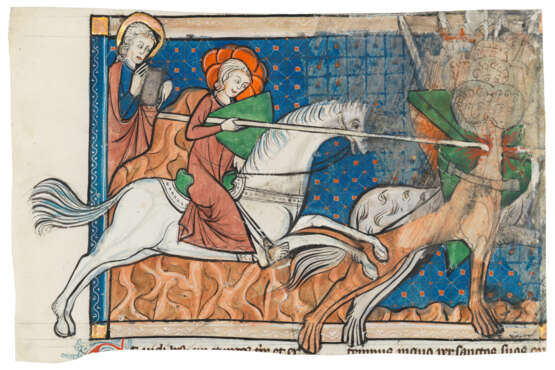ID 993330
Lot 3 | Master of the Burckhardt-Wildt Apocalypse
Valeur estimée
£ 40 000 – 60 000
The Divine Warrior Battling the Beast, and The Beast Cast into the Pool of Fire, two miniatures on either side of a cutting from the Burckhardt-Wildt Apocalypse [France (Lorraine), late 13th century (c.1290)]
An exceptional survival from the splendid 13th-century Burckhardt-Wildt Apocalypse.
103 x 162 mm, a single cutting with a large miniature on each side, each above traces of text and a decorated initial, on the recto St John the Evangelist stands to the left watching a figure with orange discs around his head, on horseback (‘behold a white horse; and he that sat upon him was called Faithful and True […] and on his head were many crowns […]’), with shield and lance spearing the neck of the seven-headed creature, on the verso the mounted figure directs a man who spears the creature and throws it into a cave while carrion birds feast on dead figures (‘the remnant were slain […] and all the fowls were filled with their flesh’) (both miniatures with some smudging, notably a deliberate attempt to literally ‘de-face’ the creature with seven heads, thus revealing the ink under-drawings, the edges cropped irregularly).
Provenance:
(1) The Bar family (see Illumination) commissioned a number of luxury manuscripts in the late 13th and early 14th centuries, and de Winter therefore suggested that a ‘likely hypothetical owner for the Burckhardt-Wildt Apocalypse might be Eleanor Plantagenet (1264–97), eldest daughter of King Edward I, 'who was already thirty on becoming the bride of Henry III of Bar in 1294’.
(2) The first appearance of the manuscript in 1796 (see below) suggests that it may have emerged from a religious house in France, dissolved a few years earlier at the Revolution.
(3) Peter Birmann (1758–1844), landscape painter and art dealer (who owned and sold, for example, the miniatures of Jean Fouquet’s Hours of Etienne Chevalier), of Basel: the present cutting was included on fol. 5 of an album with 76 other cuttings from the same Apocalypse, which he sold in 1796 to:
(4) Daniel Burckhardt-Wildt (1752–1819), silk-ribbon manufacturer, of Basel: the album passed to his descendants until sold at Sotheby’s, 25 April 1983, the present miniatures as lot 64, bought by the family of the present owner.
Text:
The presence of text on both sides of the cutting (not present or legible in most of the others) is important for an understanding of the parent manuscript, proving that it was written in Latin, in two columns, with the biblical text on the left and and the abridged commentary attributed to Berengaudus on the right. On the recto is part of Revelation 19:19, ‘Et vidi bestiam, et reges terrae, et ex[ercitus eorum …]’, with the commentary ‘[ad illud] tempus, in quo per sanctos suos con[tra Antichristum …]’ (Migne, PL, XVII, col. 928A), and on the verso part of Revelation 19:20, ‘Sic apprehensa est bestia, et cum [ea …]’, with the commentary ‘De vita iustorum dicit propheta [...]’ (ibid., col. 928C).
Illumination:
The parent manuscript was attributed in the 1983 auction catalogue to York, c.1270, by comparison with a group of manuscripts that includes a Bestiary made for the Franciscan convent in York and a Psalter with a York calendar, and stained glass at York Minster. Later the same year Patrick de Winter suggested other closer comparisons, notably an Apocalypse with a French text in the Lorraine dialect. Parallels for the style can be found in a number of other manuscripts from this region, including the Breviary of Marguerite de Bar and parts of the Breviary of her brother Renaud de Bar, which date from the late 13th and very early 14th centuries.
Literature
Nigel Morgan, ‘The Burckhardt-Wildt Apocalypse’, Art at Auction: The Year at Sotheby’s 1982–83 (London, 1983), pp. 162–69 (‘possibly York or Lincoln, circa 1280’).
Patrick M. de Winter, ‘Visions of the Apocalypse in Medieval England and France’, Bulletin of the Cleveland Museum of Art, 70, no. 10 (1983), pp. 396–417.
H.P. Kraus Inc, Catalogue 172: Illuminations: Examples of the Art of Illumination from the Thirteenth to the Early Sixteenth Century in Manuscripts and Single Miniatures (New York, 1985), nos. 12–13.
Gyllene böcker: nyförvärv och nyupptäckter [exhibition, 13 December 1987 – 6 March 1988] (Stockholm, 1987), no. 19.
Dr. Jorn Gunther Rare Books AG, Princely Magnificence: An Exhibition of Illuminated Manuscripts and Printed Books from the 13th to the 16th Century (Stalden, Switzerland, 1997), no. 17 (‘France, Verdun or Metz, c. 1290’).
Les Enluminures, Catalogue 8: Le Symbolique et le monde médiéval / Symbolism and the Medieval World (Paris, 1999), no. 7 (‘Lorraine, or perhaps England, c. 1290–1300’).
Roger S. Wieck, ‘The Burckhardt-Wildt Apocalypse’, in The Wormsley Library: A Personal Selection by Sir Paul Getty, K.B.E., ed. by H.G. Fletcher (London, 1999), no. 7 pp. 20–23.
Nigel Morgan, ‘French Interpretations of English Apocalypses’, in England and the Continent in the Middle Ages: Studies in Memory of Andrew Martindale, ed. by J. Mitchell and M. Moran, Harlaxton Medieval Studies, 8 (Stamford, 2000), pp. 137–56, passim (‘likely to have been made in Metz … in the 1290s’).
Peter Kidd, The McCarthy Collection, III: French Miniatures (London, 2021), no. 52, citing the present miniature at p. 182.
For a complete list of the miniatures, and the present location of many, see mssprovenance.blogspot.com/p/burckhardt-wildtapocalypse-miniatures.html
| Lieu d'origine: | Europe de l'Ouest, France, Europe |
|---|---|
| Catégorie maison de vente aux enchères: | Manuscrits médiévaux et de la Renaissance |
| Lieu d'origine: | Europe de l'Ouest, France, Europe |
|---|---|
| Catégorie maison de vente aux enchères: | Manuscrits médiévaux et de la Renaissance |
| Adresse de l'enchère |
CHRISTIE'S 8 King Street, St. James's SW1Y 6QT London Royaume-Uni | |
|---|---|---|
| Aperçu |
| |
| Téléphone | +44 (0)20 7839 9060 | |
| Commission | see on Website | |
| Conditions d'utilisation | Conditions d'utilisation |






